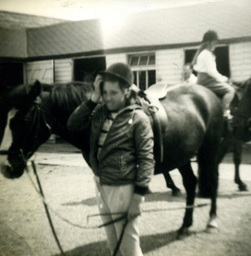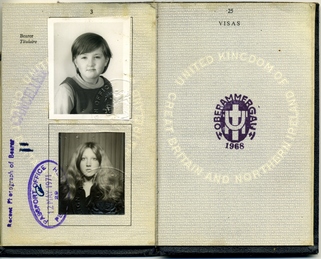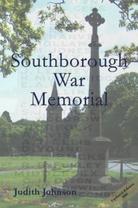 Feeling a bit worn-out at Moat House!
Feeling a bit worn-out at Moat House! I was a horse-crazy little girl. I disdained to play with dolls - my tomboy childhood was spent saddling up Champion, the Wonder-Horse, tightening his girth, filling his saddle-bags with gold, and stroking his beautiful Palomino flanks. He stood at twelve inches high, but that was no problem: I could keep him on my chest of drawers and talk to him whenever I wanted. I had a horse-shoe alarm-clock, a bookshelf full of the Pullein-Thompson sisters' Pony Club books, My Friend Flicka, Black Beauty (over which I sobbed loudly), The Horse and His
Boy etc.
I had riding-lessons with Cherrie Hatton-Hall at the Moat, her Benenden riding-stables, where Princess Anne, at boarding-school locally, also rode. I met Cherrie later in life, now become Sister Chiara, a Roman Catholic nun, but still working as Honorary Life Vice-President of Riding for the Disabled*. I loved my riding hat, jodhpurs, riding-boots, and I was fearless over jumps, never minding falling off.
My friend Joanna lived down the road from us in Cranbrook in a stunning Elizabethan manor-house, Goddards Green. Her father bred Arab horses, and they had a particularly beautiful stallion, Great Heart. I used to walk up to his field and breathe gently into his nostrils, and stroke his velvety nose. Bliss! I was usually mounted on little ponies at the Moat, so was quite envious when my Mum, courageously taking up riding in middle-age, was given a large and gorgeous chestnut mare to ride.
When my father's friend Philip Yorke inherited Erddig, near Wrexham, he invited Dad to bring the family up for a holiday. Phil had numerous enthusiasms and collections which had all fallen off when he ran out of cash - one of these was his little band of pet horses, all not quite properly trained. We kids loved them - they were naughty but spirited, and we used to gallop through the woods on the estate and the wide Maes Goch (translated from Welsh: red field, legend telling of a great battle once taking place there) in front of the house.
One day I was out with my brother Jonny when his horse Major bit mine hard on the backside. Roddy complained loudly and set off at a fast gallop along the road. I was about thirteen, I think, and didn't know that losing the other stirrup would have given me a better chance of balance. It was terrifying, and more so because I wasn't sure of where Roddy was going - I pictured him taking the fork towards the road out of the park, and colliding with an oncoming car, or crashing into the tall wrought-iron gates. But Roddy was aiming for the stables, and as we approached, a man came out and grabbed him briefly by the reins as I slid off, shaking. My Dad appeared then, and bravely went into the paddock off the stables, where Roddy had fled, and tried to catch the horse so that I could get back on. But Roddy kicked out at him, catching his ankle, an injury which would leave lasting painful effects for Dad.
They say that after a crash or an incident of this kind, you should always get back in the seat or the saddle as soon as possible, to overcome the shock. Sadly, because we couldn't catch Roddy, by the time the next morning came, I had completely lost my nerve, and even getting up on another of the horses for a photo made me tremble with fear.
Ever since then, I have never got back in the saddle. Aside from losing my nerve there has also been the question of funding for riding while bringing up baby and paying the bills. But taking up running in my mid-50s has shown me that it's never too late to follow your bliss, so I'm hoping to enrol soon for some riding-lessons at our local stables. The inner warrior is raring to go!
* When I met her in 2001 Sister Chiara Hatton-Hall told me some fascinating things about her work with Riding for the Disabled. She told me that the benefits for people with disabilities has been recognised for over 3,000 years since the time of Hippocrates, and research shows that the movement of a horse at a walking pace encourages and develops the coordination and balance of the rider and stimulates every part of the body, rotating the pelvis, so it reproduces, for those unable to walk, the same movement as if they were themselves walking. In Munich, France and Denmark, amongst other places, riding is used in psychiatric cases, with autistic children, children who have never spoken, and people with cerebral palsy. The medical profession, she told me, was becoming increasingly aware and accepting of the benefits of this therapy, especially in Europe, where it was professionally practised with remarkably successful results.


 RSS Feed
RSS Feed
